PROJMGNT 5004 Risk Management Report: Tourism Sector Analysis
VerifiedAdded on 2022/08/12
|14
|3002
|32
Report
AI Summary
This report presents a comprehensive risk management analysis for the tourism sector, specifically focusing on the context of New Zealand. The report begins with an introduction to risk management methods, including systemic, enterprise, complex systems, project, and health and safety risks. It then applies these methods to a case study in the tourism industry, identifying potential risks such as terrorism, political instability, cultural differences, and criminal activities. The report details the risk identification process, risk analysis and evaluation, and outlines risk treatment strategies, including mitigation techniques and contingency plans. A waterfall model of risk analysis is also discussed, followed by a section on monitoring and review. The conclusion emphasizes the importance of risk management in project and sector management, highlighting the numerous risks that can affect the tourism sector.
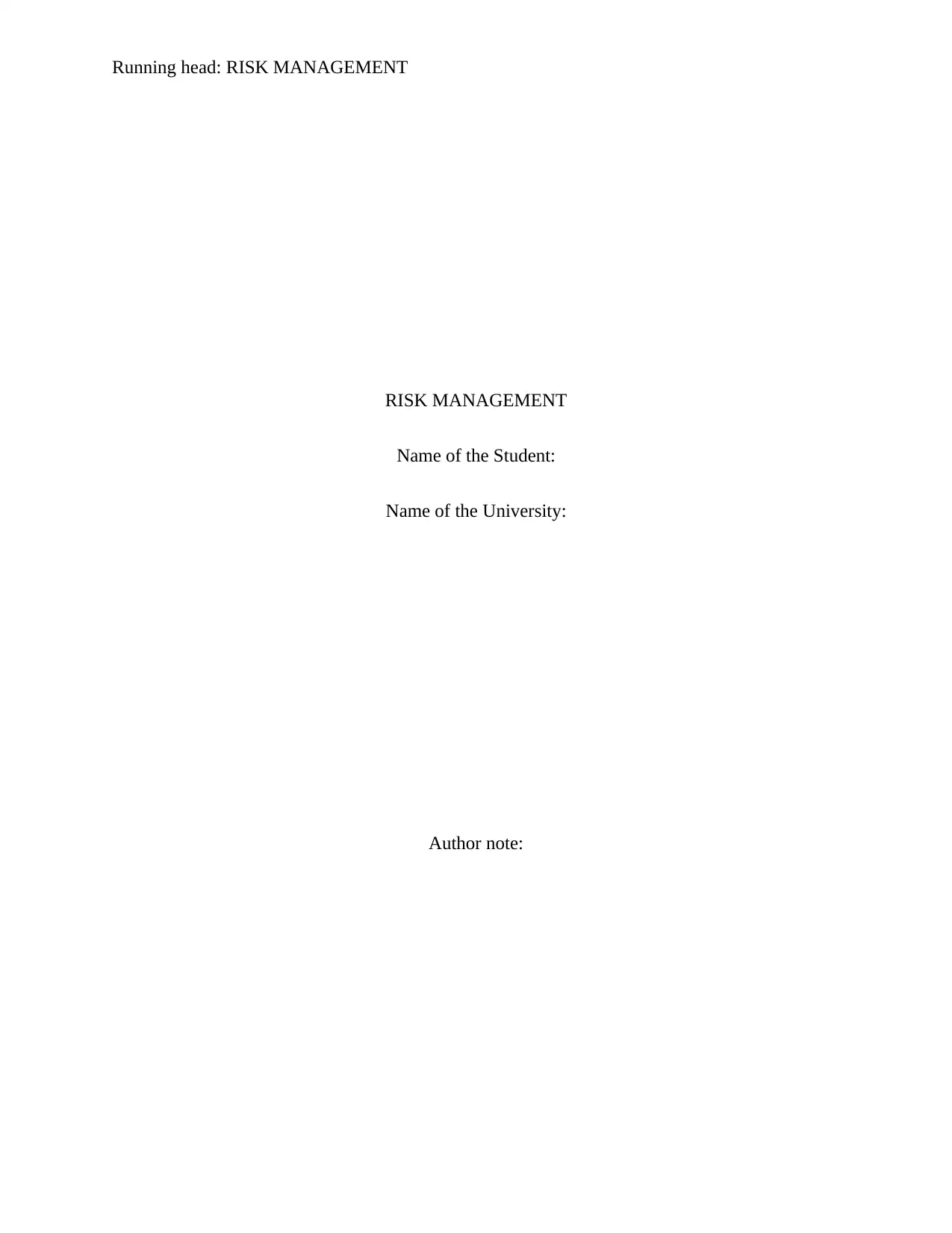
Running head: RISK MANAGEMENT
RISK MANAGEMENT
Name of the Student:
Name of the University:
Author note:
RISK MANAGEMENT
Name of the Student:
Name of the University:
Author note:
Paraphrase This Document
Need a fresh take? Get an instant paraphrase of this document with our AI Paraphraser
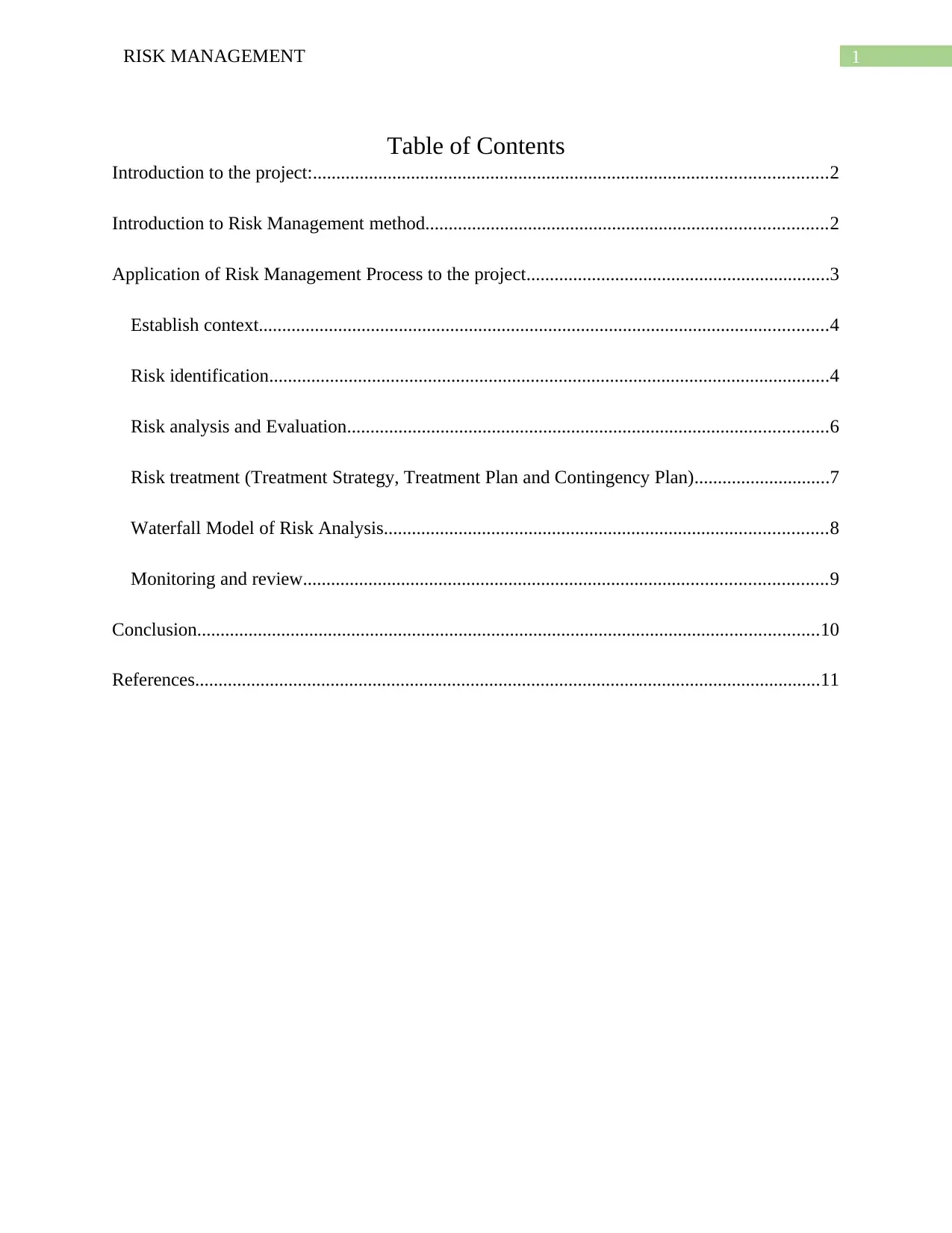
1RISK MANAGEMENT
Table of Contents
Introduction to the project:..............................................................................................................2
Introduction to Risk Management method......................................................................................2
Application of Risk Management Process to the project.................................................................3
Establish context..........................................................................................................................4
Risk identification........................................................................................................................4
Risk analysis and Evaluation.......................................................................................................6
Risk treatment (Treatment Strategy, Treatment Plan and Contingency Plan).............................7
Waterfall Model of Risk Analysis...............................................................................................8
Monitoring and review................................................................................................................9
Conclusion.....................................................................................................................................10
References......................................................................................................................................11
Table of Contents
Introduction to the project:..............................................................................................................2
Introduction to Risk Management method......................................................................................2
Application of Risk Management Process to the project.................................................................3
Establish context..........................................................................................................................4
Risk identification........................................................................................................................4
Risk analysis and Evaluation.......................................................................................................6
Risk treatment (Treatment Strategy, Treatment Plan and Contingency Plan).............................7
Waterfall Model of Risk Analysis...............................................................................................8
Monitoring and review................................................................................................................9
Conclusion.....................................................................................................................................10
References......................................................................................................................................11
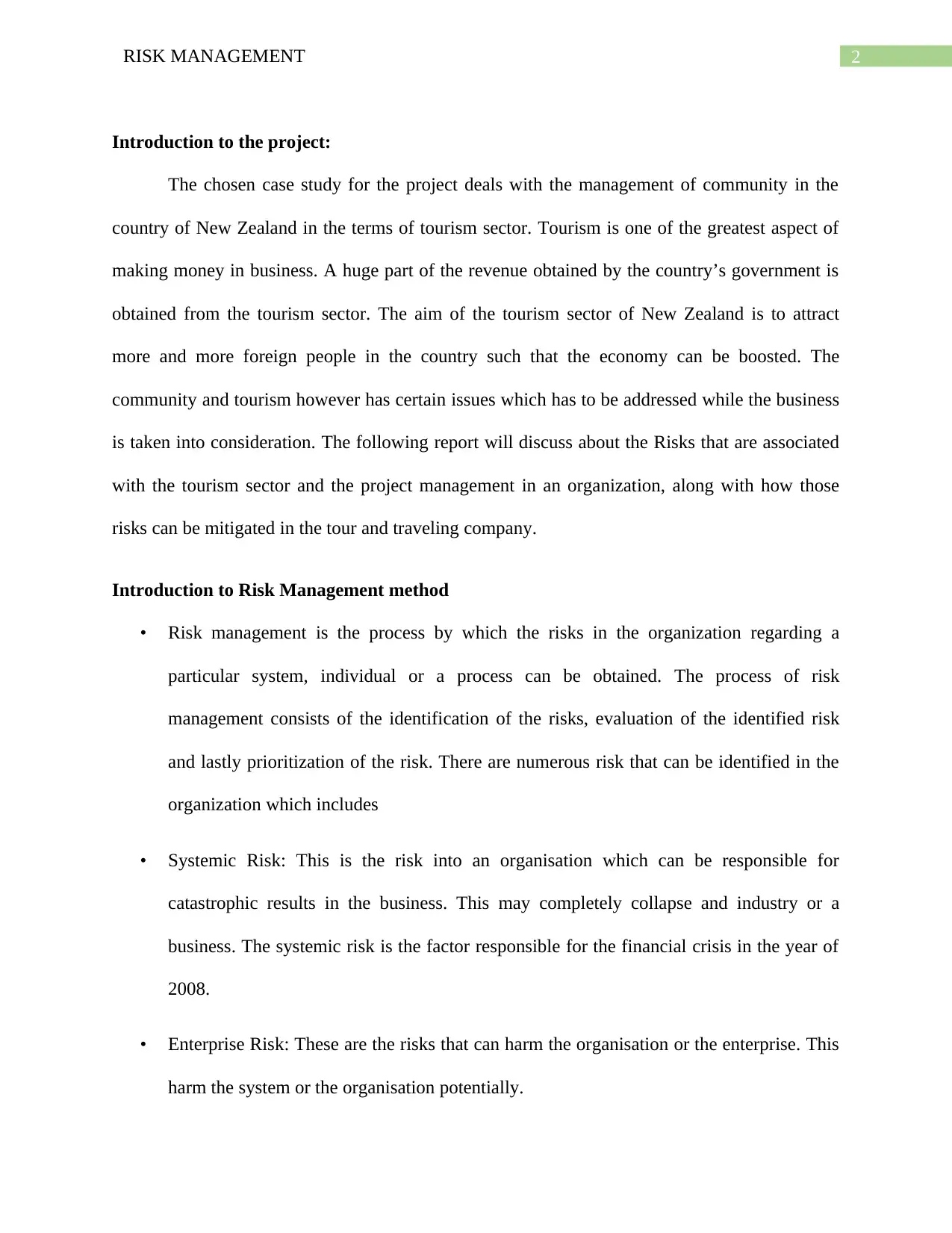
2RISK MANAGEMENT
Introduction to the project:
The chosen case study for the project deals with the management of community in the
country of New Zealand in the terms of tourism sector. Tourism is one of the greatest aspect of
making money in business. A huge part of the revenue obtained by the country’s government is
obtained from the tourism sector. The aim of the tourism sector of New Zealand is to attract
more and more foreign people in the country such that the economy can be boosted. The
community and tourism however has certain issues which has to be addressed while the business
is taken into consideration. The following report will discuss about the Risks that are associated
with the tourism sector and the project management in an organization, along with how those
risks can be mitigated in the tour and traveling company.
Introduction to Risk Management method
• Risk management is the process by which the risks in the organization regarding a
particular system, individual or a process can be obtained. The process of risk
management consists of the identification of the risks, evaluation of the identified risk
and lastly prioritization of the risk. There are numerous risk that can be identified in the
organization which includes
• Systemic Risk: This is the risk into an organisation which can be responsible for
catastrophic results in the business. This may completely collapse and industry or a
business. The systemic risk is the factor responsible for the financial crisis in the year of
2008.
• Enterprise Risk: These are the risks that can harm the organisation or the enterprise. This
harm the system or the organisation potentially.
Introduction to the project:
The chosen case study for the project deals with the management of community in the
country of New Zealand in the terms of tourism sector. Tourism is one of the greatest aspect of
making money in business. A huge part of the revenue obtained by the country’s government is
obtained from the tourism sector. The aim of the tourism sector of New Zealand is to attract
more and more foreign people in the country such that the economy can be boosted. The
community and tourism however has certain issues which has to be addressed while the business
is taken into consideration. The following report will discuss about the Risks that are associated
with the tourism sector and the project management in an organization, along with how those
risks can be mitigated in the tour and traveling company.
Introduction to Risk Management method
• Risk management is the process by which the risks in the organization regarding a
particular system, individual or a process can be obtained. The process of risk
management consists of the identification of the risks, evaluation of the identified risk
and lastly prioritization of the risk. There are numerous risk that can be identified in the
organization which includes
• Systemic Risk: This is the risk into an organisation which can be responsible for
catastrophic results in the business. This may completely collapse and industry or a
business. The systemic risk is the factor responsible for the financial crisis in the year of
2008.
• Enterprise Risk: These are the risks that can harm the organisation or the enterprise. This
harm the system or the organisation potentially.
⊘ This is a preview!⊘
Do you want full access?
Subscribe today to unlock all pages.

Trusted by 1+ million students worldwide
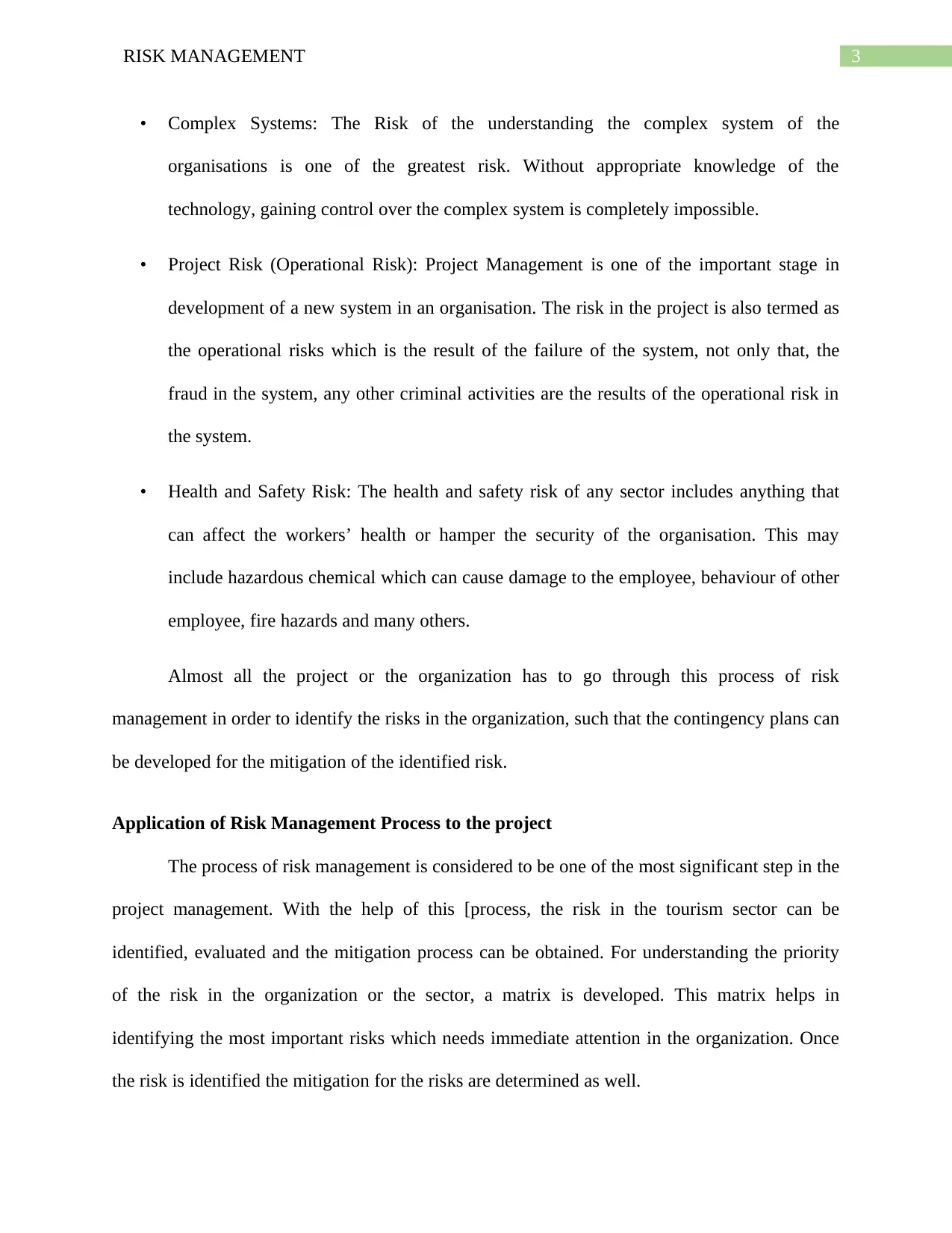
3RISK MANAGEMENT
• Complex Systems: The Risk of the understanding the complex system of the
organisations is one of the greatest risk. Without appropriate knowledge of the
technology, gaining control over the complex system is completely impossible.
• Project Risk (Operational Risk): Project Management is one of the important stage in
development of a new system in an organisation. The risk in the project is also termed as
the operational risks which is the result of the failure of the system, not only that, the
fraud in the system, any other criminal activities are the results of the operational risk in
the system.
• Health and Safety Risk: The health and safety risk of any sector includes anything that
can affect the workers’ health or hamper the security of the organisation. This may
include hazardous chemical which can cause damage to the employee, behaviour of other
employee, fire hazards and many others.
Almost all the project or the organization has to go through this process of risk
management in order to identify the risks in the organization, such that the contingency plans can
be developed for the mitigation of the identified risk.
Application of Risk Management Process to the project
The process of risk management is considered to be one of the most significant step in the
project management. With the help of this [process, the risk in the tourism sector can be
identified, evaluated and the mitigation process can be obtained. For understanding the priority
of the risk in the organization or the sector, a matrix is developed. This matrix helps in
identifying the most important risks which needs immediate attention in the organization. Once
the risk is identified the mitigation for the risks are determined as well.
• Complex Systems: The Risk of the understanding the complex system of the
organisations is one of the greatest risk. Without appropriate knowledge of the
technology, gaining control over the complex system is completely impossible.
• Project Risk (Operational Risk): Project Management is one of the important stage in
development of a new system in an organisation. The risk in the project is also termed as
the operational risks which is the result of the failure of the system, not only that, the
fraud in the system, any other criminal activities are the results of the operational risk in
the system.
• Health and Safety Risk: The health and safety risk of any sector includes anything that
can affect the workers’ health or hamper the security of the organisation. This may
include hazardous chemical which can cause damage to the employee, behaviour of other
employee, fire hazards and many others.
Almost all the project or the organization has to go through this process of risk
management in order to identify the risks in the organization, such that the contingency plans can
be developed for the mitigation of the identified risk.
Application of Risk Management Process to the project
The process of risk management is considered to be one of the most significant step in the
project management. With the help of this [process, the risk in the tourism sector can be
identified, evaluated and the mitigation process can be obtained. For understanding the priority
of the risk in the organization or the sector, a matrix is developed. This matrix helps in
identifying the most important risks which needs immediate attention in the organization. Once
the risk is identified the mitigation for the risks are determined as well.
Paraphrase This Document
Need a fresh take? Get an instant paraphrase of this document with our AI Paraphraser
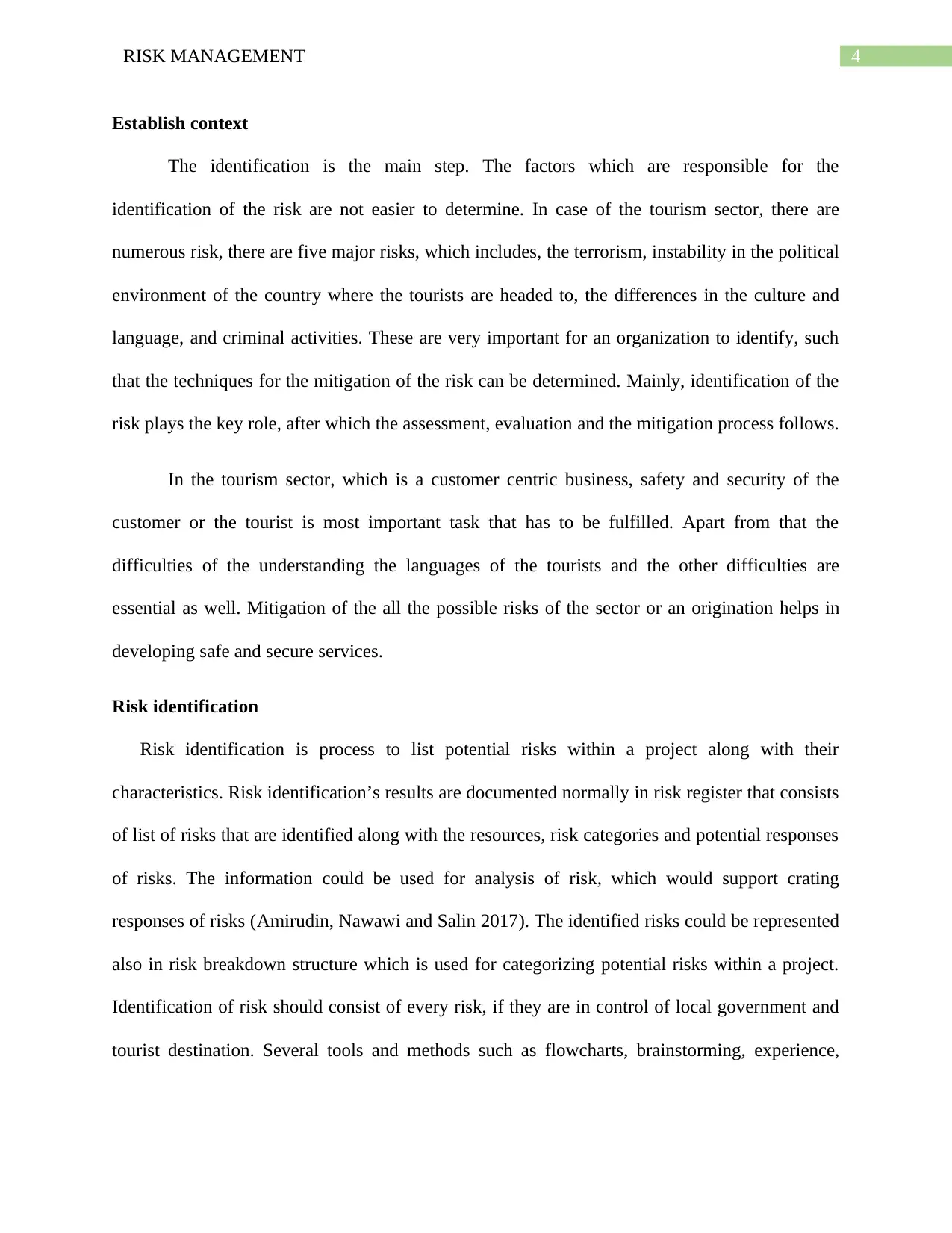
4RISK MANAGEMENT
Establish context
The identification is the main step. The factors which are responsible for the
identification of the risk are not easier to determine. In case of the tourism sector, there are
numerous risk, there are five major risks, which includes, the terrorism, instability in the political
environment of the country where the tourists are headed to, the differences in the culture and
language, and criminal activities. These are very important for an organization to identify, such
that the techniques for the mitigation of the risk can be determined. Mainly, identification of the
risk plays the key role, after which the assessment, evaluation and the mitigation process follows.
In the tourism sector, which is a customer centric business, safety and security of the
customer or the tourist is most important task that has to be fulfilled. Apart from that the
difficulties of the understanding the languages of the tourists and the other difficulties are
essential as well. Mitigation of the all the possible risks of the sector or an origination helps in
developing safe and secure services.
Risk identification
Risk identification is process to list potential risks within a project along with their
characteristics. Risk identification’s results are documented normally in risk register that consists
of list of risks that are identified along with the resources, risk categories and potential responses
of risks. The information could be used for analysis of risk, which would support crating
responses of risks (Amirudin, Nawawi and Salin 2017). The identified risks could be represented
also in risk breakdown structure which is used for categorizing potential risks within a project.
Identification of risk should consist of every risk, if they are in control of local government and
tourist destination. Several tools and methods such as flowcharts, brainstorming, experience,
Establish context
The identification is the main step. The factors which are responsible for the
identification of the risk are not easier to determine. In case of the tourism sector, there are
numerous risk, there are five major risks, which includes, the terrorism, instability in the political
environment of the country where the tourists are headed to, the differences in the culture and
language, and criminal activities. These are very important for an organization to identify, such
that the techniques for the mitigation of the risk can be determined. Mainly, identification of the
risk plays the key role, after which the assessment, evaluation and the mitigation process follows.
In the tourism sector, which is a customer centric business, safety and security of the
customer or the tourist is most important task that has to be fulfilled. Apart from that the
difficulties of the understanding the languages of the tourists and the other difficulties are
essential as well. Mitigation of the all the possible risks of the sector or an origination helps in
developing safe and secure services.
Risk identification
Risk identification is process to list potential risks within a project along with their
characteristics. Risk identification’s results are documented normally in risk register that consists
of list of risks that are identified along with the resources, risk categories and potential responses
of risks. The information could be used for analysis of risk, which would support crating
responses of risks (Amirudin, Nawawi and Salin 2017). The identified risks could be represented
also in risk breakdown structure which is used for categorizing potential risks within a project.
Identification of risk should consist of every risk, if they are in control of local government and
tourist destination. Several tools and methods such as flowcharts, brainstorming, experience,
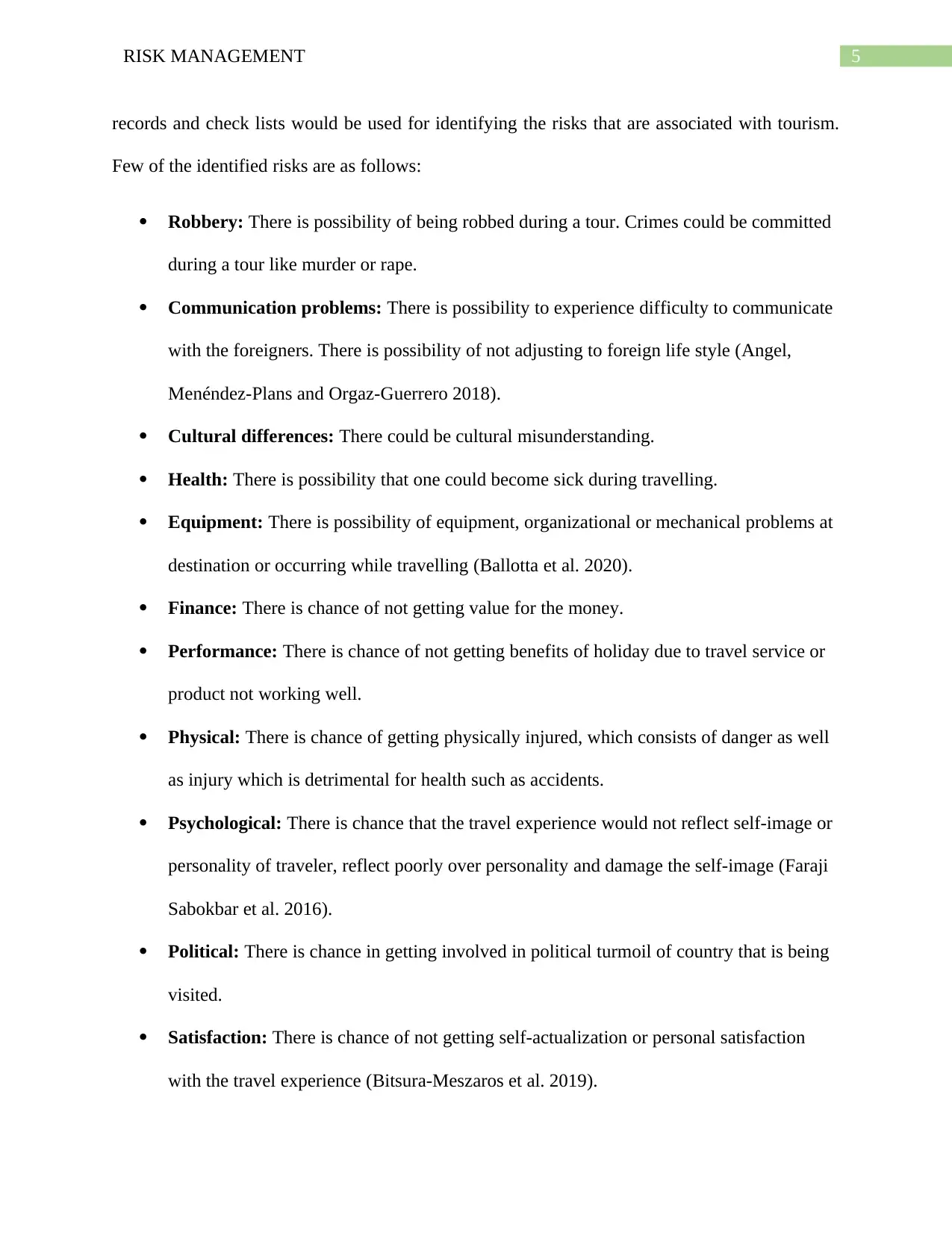
5RISK MANAGEMENT
records and check lists would be used for identifying the risks that are associated with tourism.
Few of the identified risks are as follows:
Robbery: There is possibility of being robbed during a tour. Crimes could be committed
during a tour like murder or rape.
Communication problems: There is possibility to experience difficulty to communicate
with the foreigners. There is possibility of not adjusting to foreign life style (Angel,
Menéndez-Plans and Orgaz-Guerrero 2018).
Cultural differences: There could be cultural misunderstanding.
Health: There is possibility that one could become sick during travelling.
Equipment: There is possibility of equipment, organizational or mechanical problems at
destination or occurring while travelling (Ballotta et al. 2020).
Finance: There is chance of not getting value for the money.
Performance: There is chance of not getting benefits of holiday due to travel service or
product not working well.
Physical: There is chance of getting physically injured, which consists of danger as well
as injury which is detrimental for health such as accidents.
Psychological: There is chance that the travel experience would not reflect self-image or
personality of traveler, reflect poorly over personality and damage the self-image (Faraji
Sabokbar et al. 2016).
Political: There is chance in getting involved in political turmoil of country that is being
visited.
Satisfaction: There is chance of not getting self-actualization or personal satisfaction
with the travel experience (Bitsura-Meszaros et al. 2019).
records and check lists would be used for identifying the risks that are associated with tourism.
Few of the identified risks are as follows:
Robbery: There is possibility of being robbed during a tour. Crimes could be committed
during a tour like murder or rape.
Communication problems: There is possibility to experience difficulty to communicate
with the foreigners. There is possibility of not adjusting to foreign life style (Angel,
Menéndez-Plans and Orgaz-Guerrero 2018).
Cultural differences: There could be cultural misunderstanding.
Health: There is possibility that one could become sick during travelling.
Equipment: There is possibility of equipment, organizational or mechanical problems at
destination or occurring while travelling (Ballotta et al. 2020).
Finance: There is chance of not getting value for the money.
Performance: There is chance of not getting benefits of holiday due to travel service or
product not working well.
Physical: There is chance of getting physically injured, which consists of danger as well
as injury which is detrimental for health such as accidents.
Psychological: There is chance that the travel experience would not reflect self-image or
personality of traveler, reflect poorly over personality and damage the self-image (Faraji
Sabokbar et al. 2016).
Political: There is chance in getting involved in political turmoil of country that is being
visited.
Satisfaction: There is chance of not getting self-actualization or personal satisfaction
with the travel experience (Bitsura-Meszaros et al. 2019).
⊘ This is a preview!⊘
Do you want full access?
Subscribe today to unlock all pages.

Trusted by 1+ million students worldwide
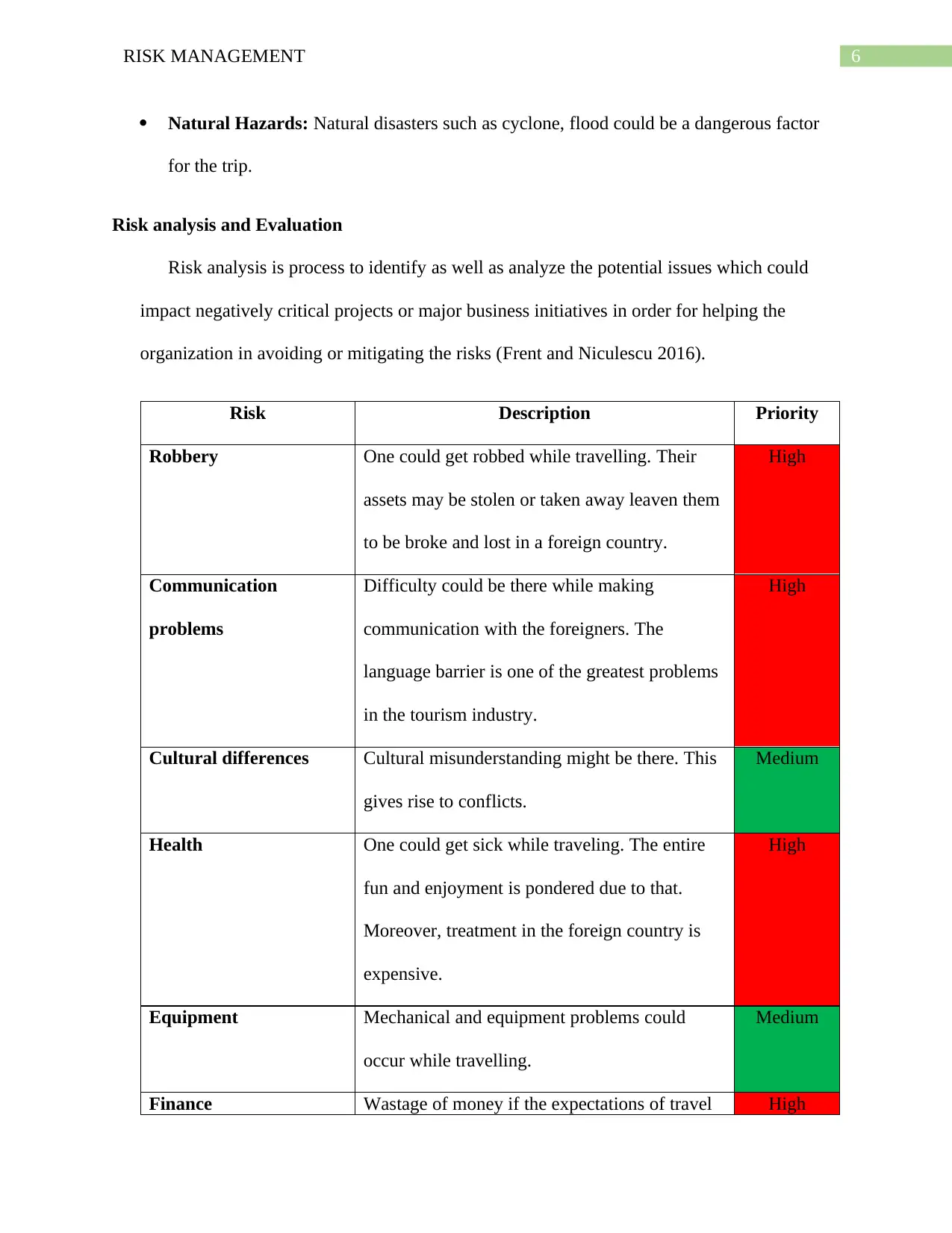
6RISK MANAGEMENT
Natural Hazards: Natural disasters such as cyclone, flood could be a dangerous factor
for the trip.
Risk analysis and Evaluation
Risk analysis is process to identify as well as analyze the potential issues which could
impact negatively critical projects or major business initiatives in order for helping the
organization in avoiding or mitigating the risks (Frent and Niculescu 2016).
Risk Description Priority
Robbery One could get robbed while travelling. Their
assets may be stolen or taken away leaven them
to be broke and lost in a foreign country.
High
Communication
problems
Difficulty could be there while making
communication with the foreigners. The
language barrier is one of the greatest problems
in the tourism industry.
High
Cultural differences Cultural misunderstanding might be there. This
gives rise to conflicts.
Medium
Health One could get sick while traveling. The entire
fun and enjoyment is pondered due to that.
Moreover, treatment in the foreign country is
expensive.
High
Equipment Mechanical and equipment problems could
occur while travelling.
Medium
Finance Wastage of money if the expectations of travel High
Natural Hazards: Natural disasters such as cyclone, flood could be a dangerous factor
for the trip.
Risk analysis and Evaluation
Risk analysis is process to identify as well as analyze the potential issues which could
impact negatively critical projects or major business initiatives in order for helping the
organization in avoiding or mitigating the risks (Frent and Niculescu 2016).
Risk Description Priority
Robbery One could get robbed while travelling. Their
assets may be stolen or taken away leaven them
to be broke and lost in a foreign country.
High
Communication
problems
Difficulty could be there while making
communication with the foreigners. The
language barrier is one of the greatest problems
in the tourism industry.
High
Cultural differences Cultural misunderstanding might be there. This
gives rise to conflicts.
Medium
Health One could get sick while traveling. The entire
fun and enjoyment is pondered due to that.
Moreover, treatment in the foreign country is
expensive.
High
Equipment Mechanical and equipment problems could
occur while travelling.
Medium
Finance Wastage of money if the expectations of travel High
Paraphrase This Document
Need a fresh take? Get an instant paraphrase of this document with our AI Paraphraser
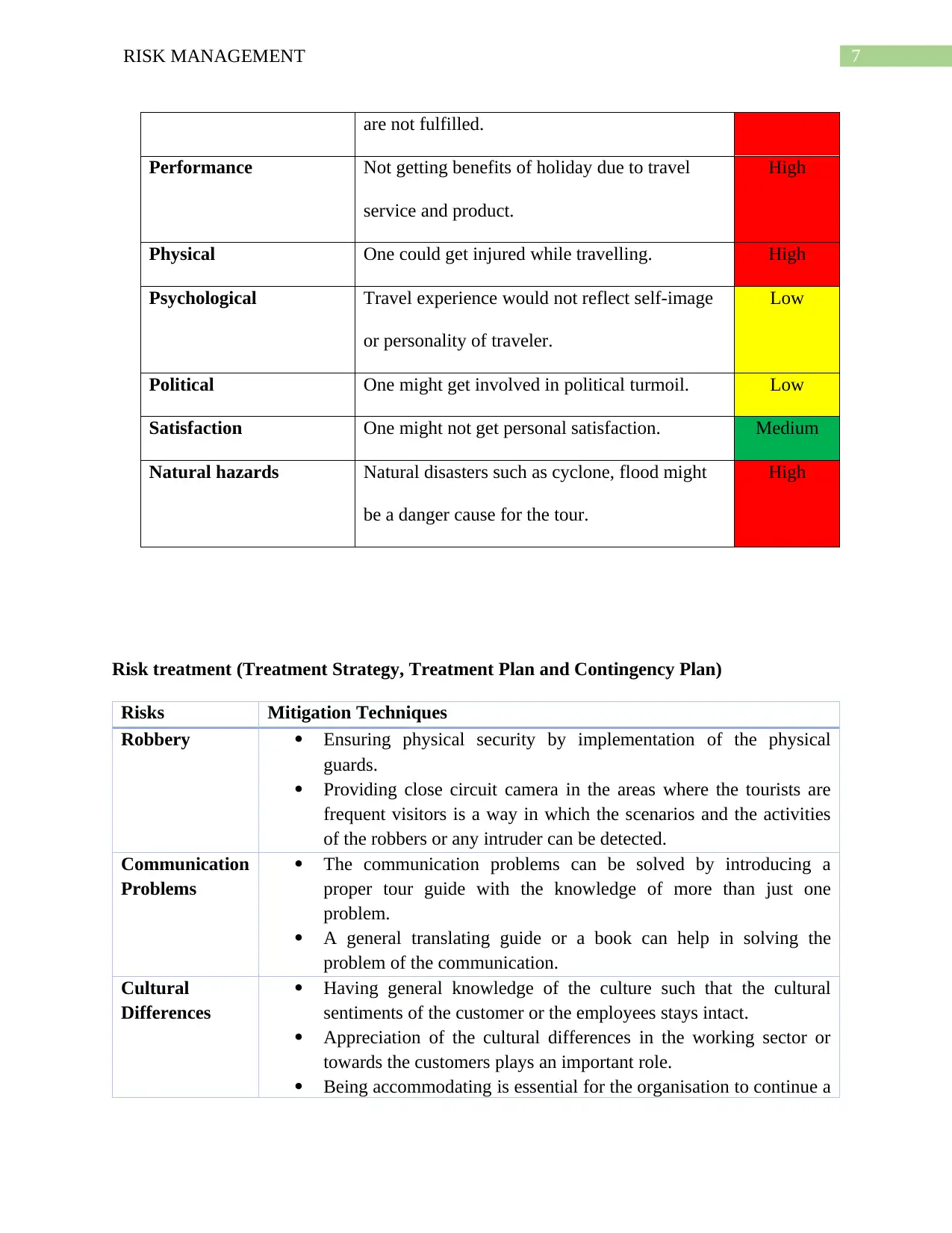
7RISK MANAGEMENT
are not fulfilled.
Performance Not getting benefits of holiday due to travel
service and product.
High
Physical One could get injured while travelling. High
Psychological Travel experience would not reflect self-image
or personality of traveler.
Low
Political One might get involved in political turmoil. Low
Satisfaction One might not get personal satisfaction. Medium
Natural hazards Natural disasters such as cyclone, flood might
be a danger cause for the tour.
High
Risk treatment (Treatment Strategy, Treatment Plan and Contingency Plan)
Risks Mitigation Techniques
Robbery Ensuring physical security by implementation of the physical
guards.
Providing close circuit camera in the areas where the tourists are
frequent visitors is a way in which the scenarios and the activities
of the robbers or any intruder can be detected.
Communication
Problems
The communication problems can be solved by introducing a
proper tour guide with the knowledge of more than just one
problem.
A general translating guide or a book can help in solving the
problem of the communication.
Cultural
Differences
Having general knowledge of the culture such that the cultural
sentiments of the customer or the employees stays intact.
Appreciation of the cultural differences in the working sector or
towards the customers plays an important role.
Being accommodating is essential for the organisation to continue a
are not fulfilled.
Performance Not getting benefits of holiday due to travel
service and product.
High
Physical One could get injured while travelling. High
Psychological Travel experience would not reflect self-image
or personality of traveler.
Low
Political One might get involved in political turmoil. Low
Satisfaction One might not get personal satisfaction. Medium
Natural hazards Natural disasters such as cyclone, flood might
be a danger cause for the tour.
High
Risk treatment (Treatment Strategy, Treatment Plan and Contingency Plan)
Risks Mitigation Techniques
Robbery Ensuring physical security by implementation of the physical
guards.
Providing close circuit camera in the areas where the tourists are
frequent visitors is a way in which the scenarios and the activities
of the robbers or any intruder can be detected.
Communication
Problems
The communication problems can be solved by introducing a
proper tour guide with the knowledge of more than just one
problem.
A general translating guide or a book can help in solving the
problem of the communication.
Cultural
Differences
Having general knowledge of the culture such that the cultural
sentiments of the customer or the employees stays intact.
Appreciation of the cultural differences in the working sector or
towards the customers plays an important role.
Being accommodating is essential for the organisation to continue a
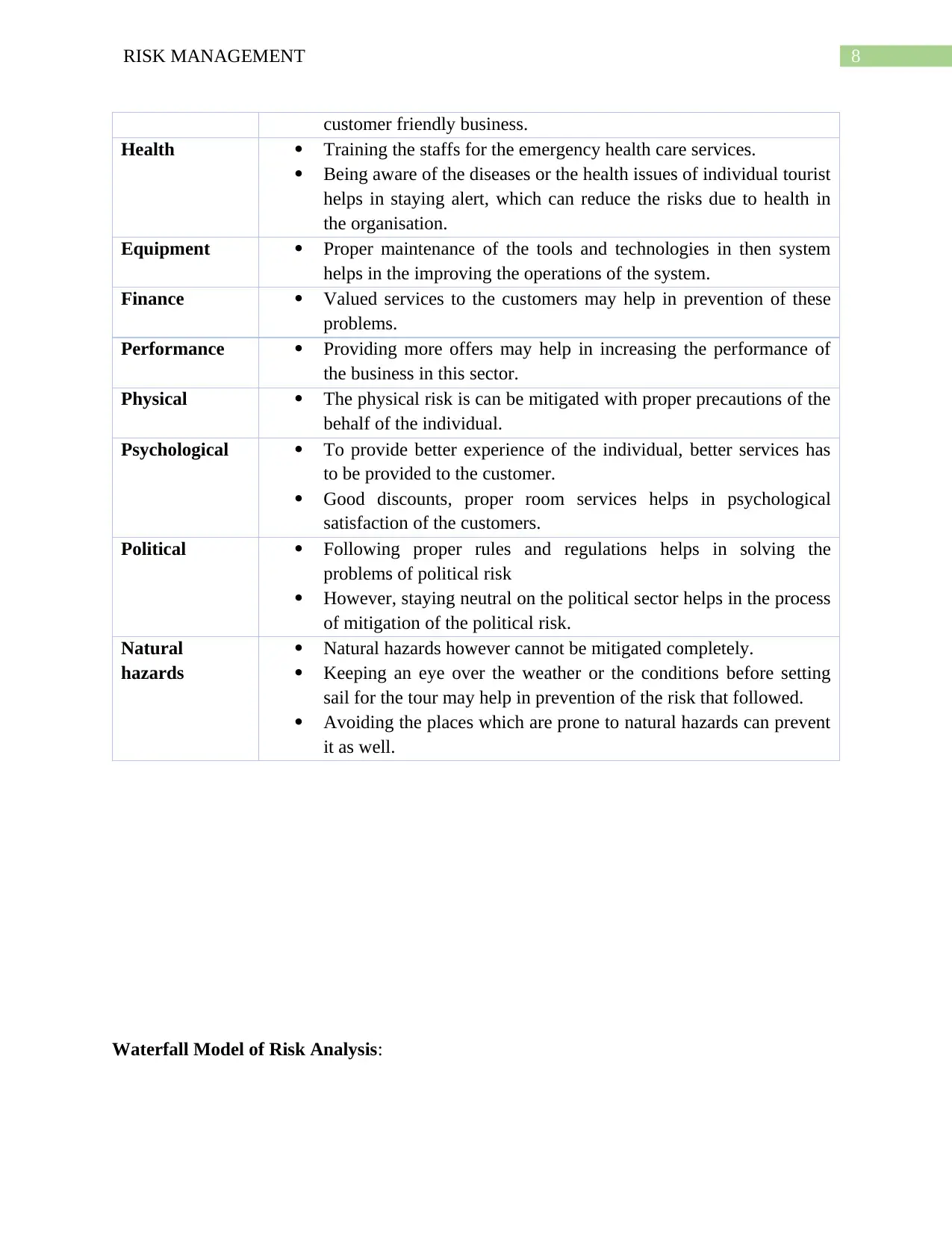
8RISK MANAGEMENT
customer friendly business.
Health Training the staffs for the emergency health care services.
Being aware of the diseases or the health issues of individual tourist
helps in staying alert, which can reduce the risks due to health in
the organisation.
Equipment Proper maintenance of the tools and technologies in then system
helps in the improving the operations of the system.
Finance Valued services to the customers may help in prevention of these
problems.
Performance Providing more offers may help in increasing the performance of
the business in this sector.
Physical The physical risk is can be mitigated with proper precautions of the
behalf of the individual.
Psychological To provide better experience of the individual, better services has
to be provided to the customer.
Good discounts, proper room services helps in psychological
satisfaction of the customers.
Political Following proper rules and regulations helps in solving the
problems of political risk
However, staying neutral on the political sector helps in the process
of mitigation of the political risk.
Natural
hazards
Natural hazards however cannot be mitigated completely.
Keeping an eye over the weather or the conditions before setting
sail for the tour may help in prevention of the risk that followed.
Avoiding the places which are prone to natural hazards can prevent
it as well.
Waterfall Model of Risk Analysis:
customer friendly business.
Health Training the staffs for the emergency health care services.
Being aware of the diseases or the health issues of individual tourist
helps in staying alert, which can reduce the risks due to health in
the organisation.
Equipment Proper maintenance of the tools and technologies in then system
helps in the improving the operations of the system.
Finance Valued services to the customers may help in prevention of these
problems.
Performance Providing more offers may help in increasing the performance of
the business in this sector.
Physical The physical risk is can be mitigated with proper precautions of the
behalf of the individual.
Psychological To provide better experience of the individual, better services has
to be provided to the customer.
Good discounts, proper room services helps in psychological
satisfaction of the customers.
Political Following proper rules and regulations helps in solving the
problems of political risk
However, staying neutral on the political sector helps in the process
of mitigation of the political risk.
Natural
hazards
Natural hazards however cannot be mitigated completely.
Keeping an eye over the weather or the conditions before setting
sail for the tour may help in prevention of the risk that followed.
Avoiding the places which are prone to natural hazards can prevent
it as well.
Waterfall Model of Risk Analysis:
⊘ This is a preview!⊘
Do you want full access?
Subscribe today to unlock all pages.

Trusted by 1+ million students worldwide
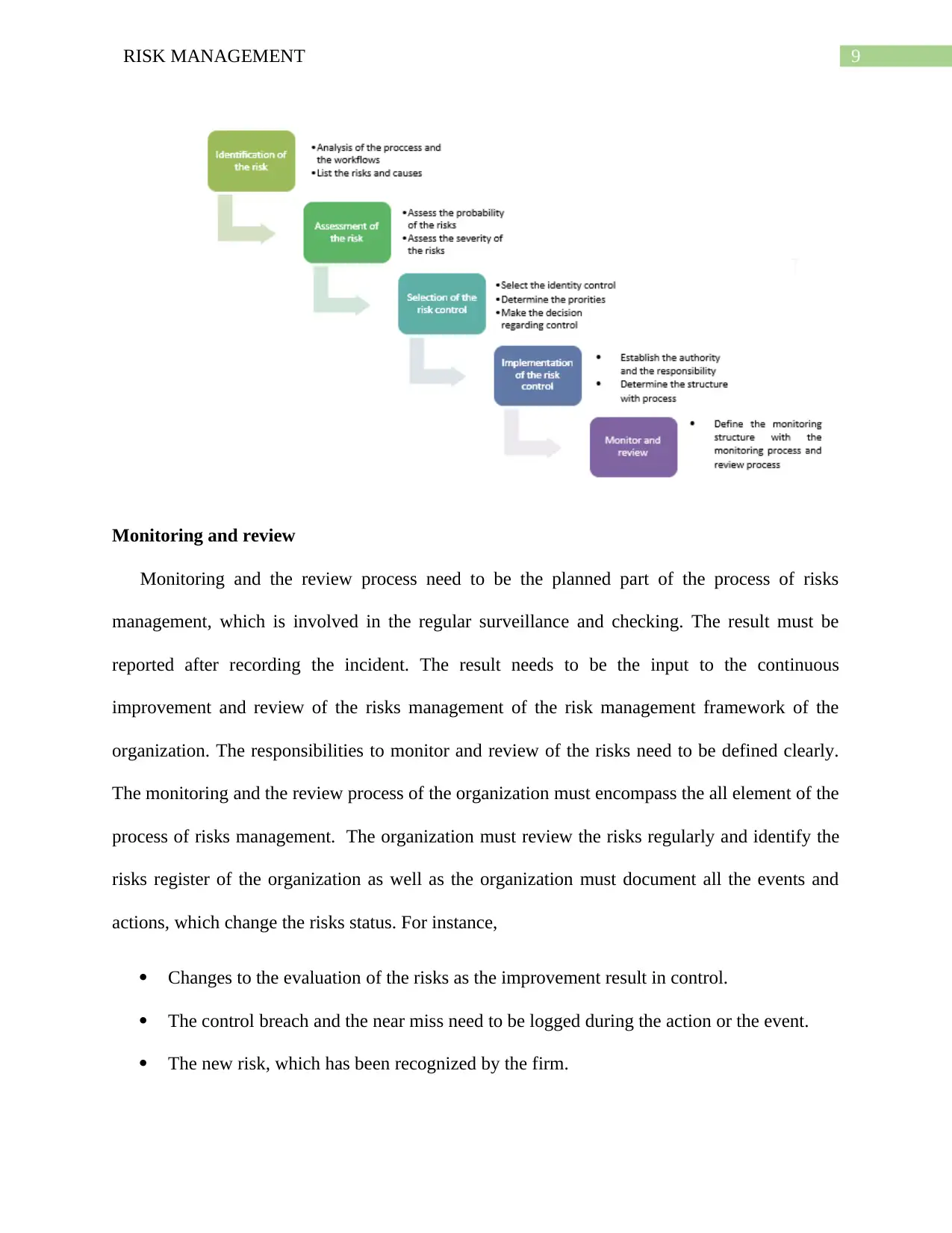
9RISK MANAGEMENT
Monitoring and review
Monitoring and the review process need to be the planned part of the process of risks
management, which is involved in the regular surveillance and checking. The result must be
reported after recording the incident. The result needs to be the input to the continuous
improvement and review of the risks management of the risk management framework of the
organization. The responsibilities to monitor and review of the risks need to be defined clearly.
The monitoring and the review process of the organization must encompass the all element of the
process of risks management. The organization must review the risks regularly and identify the
risks register of the organization as well as the organization must document all the events and
actions, which change the risks status. For instance,
Changes to the evaluation of the risks as the improvement result in control.
The control breach and the near miss need to be logged during the action or the event.
The new risk, which has been recognized by the firm.
Monitoring and review
Monitoring and the review process need to be the planned part of the process of risks
management, which is involved in the regular surveillance and checking. The result must be
reported after recording the incident. The result needs to be the input to the continuous
improvement and review of the risks management of the risk management framework of the
organization. The responsibilities to monitor and review of the risks need to be defined clearly.
The monitoring and the review process of the organization must encompass the all element of the
process of risks management. The organization must review the risks regularly and identify the
risks register of the organization as well as the organization must document all the events and
actions, which change the risks status. For instance,
Changes to the evaluation of the risks as the improvement result in control.
The control breach and the near miss need to be logged during the action or the event.
The new risk, which has been recognized by the firm.
Paraphrase This Document
Need a fresh take? Get an instant paraphrase of this document with our AI Paraphraser
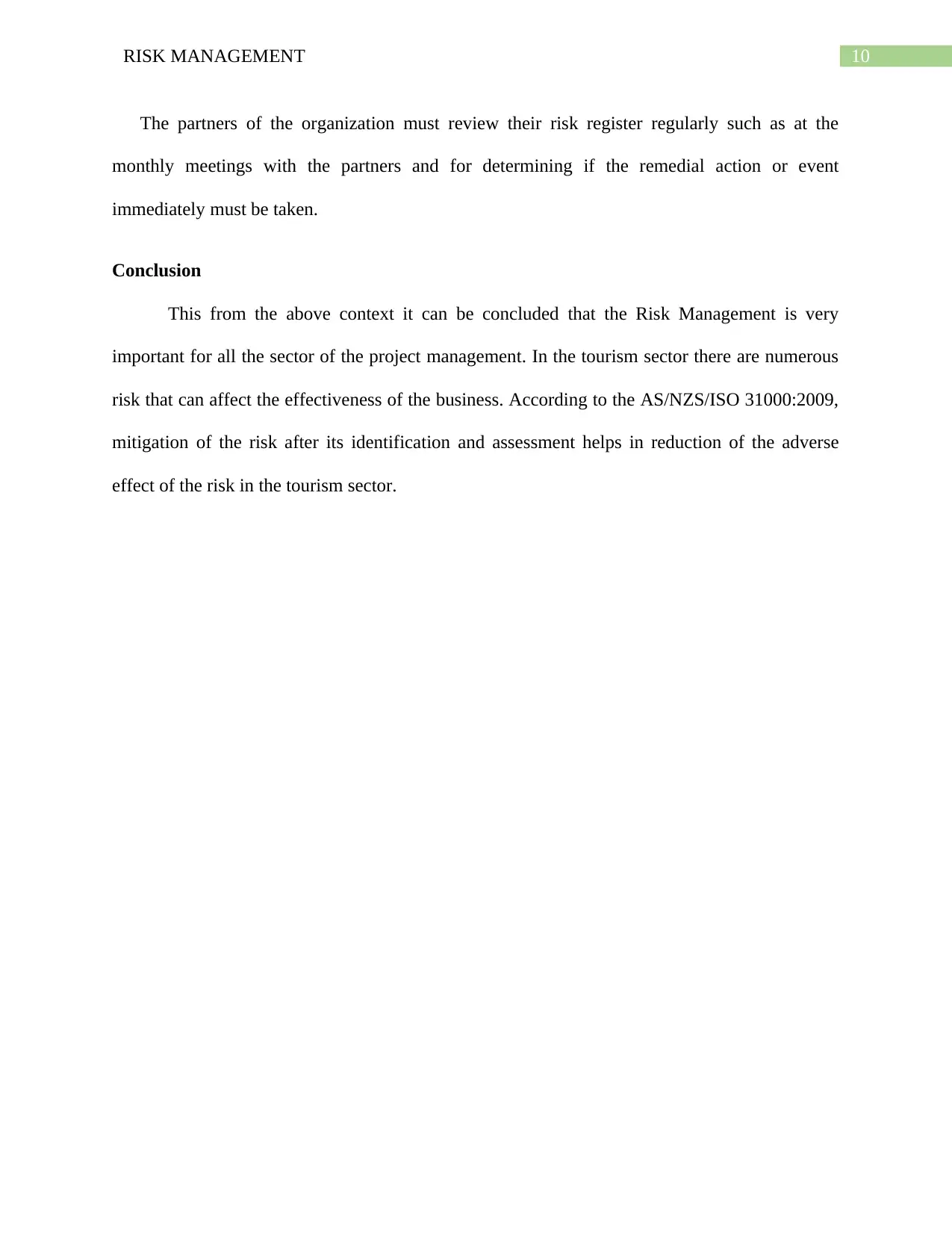
10RISK MANAGEMENT
The partners of the organization must review their risk register regularly such as at the
monthly meetings with the partners and for determining if the remedial action or event
immediately must be taken.
Conclusion
This from the above context it can be concluded that the Risk Management is very
important for all the sector of the project management. In the tourism sector there are numerous
risk that can affect the effectiveness of the business. According to the AS/NZS/ISO 31000:2009,
mitigation of the risk after its identification and assessment helps in reduction of the adverse
effect of the risk in the tourism sector.
The partners of the organization must review their risk register regularly such as at the
monthly meetings with the partners and for determining if the remedial action or event
immediately must be taken.
Conclusion
This from the above context it can be concluded that the Risk Management is very
important for all the sector of the project management. In the tourism sector there are numerous
risk that can affect the effectiveness of the business. According to the AS/NZS/ISO 31000:2009,
mitigation of the risk after its identification and assessment helps in reduction of the adverse
effect of the risk in the tourism sector.
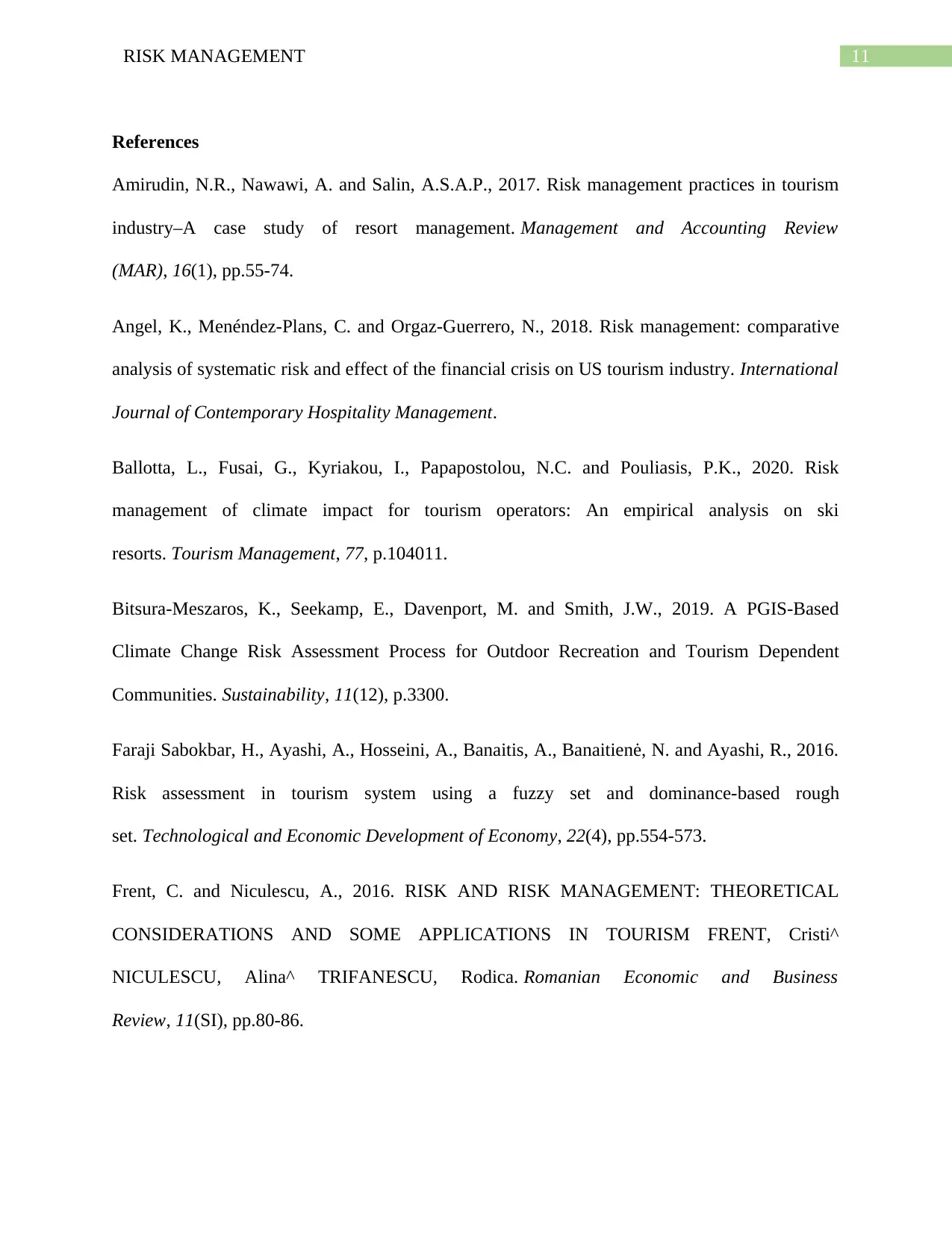
11RISK MANAGEMENT
References
Amirudin, N.R., Nawawi, A. and Salin, A.S.A.P., 2017. Risk management practices in tourism
industry–A case study of resort management. Management and Accounting Review
(MAR), 16(1), pp.55-74.
Angel, K., Menéndez-Plans, C. and Orgaz-Guerrero, N., 2018. Risk management: comparative
analysis of systematic risk and effect of the financial crisis on US tourism industry. International
Journal of Contemporary Hospitality Management.
Ballotta, L., Fusai, G., Kyriakou, I., Papapostolou, N.C. and Pouliasis, P.K., 2020. Risk
management of climate impact for tourism operators: An empirical analysis on ski
resorts. Tourism Management, 77, p.104011.
Bitsura-Meszaros, K., Seekamp, E., Davenport, M. and Smith, J.W., 2019. A PGIS-Based
Climate Change Risk Assessment Process for Outdoor Recreation and Tourism Dependent
Communities. Sustainability, 11(12), p.3300.
Faraji Sabokbar, H., Ayashi, A., Hosseini, A., Banaitis, A., Banaitienė, N. and Ayashi, R., 2016.
Risk assessment in tourism system using a fuzzy set and dominance-based rough
set. Technological and Economic Development of Economy, 22(4), pp.554-573.
Frent, C. and Niculescu, A., 2016. RISK AND RISK MANAGEMENT: THEORETICAL
CONSIDERATIONS AND SOME APPLICATIONS IN TOURISM FRENT, Cristi^
NICULESCU, Alina^ TRIFANESCU, Rodica. Romanian Economic and Business
Review, 11(SI), pp.80-86.
References
Amirudin, N.R., Nawawi, A. and Salin, A.S.A.P., 2017. Risk management practices in tourism
industry–A case study of resort management. Management and Accounting Review
(MAR), 16(1), pp.55-74.
Angel, K., Menéndez-Plans, C. and Orgaz-Guerrero, N., 2018. Risk management: comparative
analysis of systematic risk and effect of the financial crisis on US tourism industry. International
Journal of Contemporary Hospitality Management.
Ballotta, L., Fusai, G., Kyriakou, I., Papapostolou, N.C. and Pouliasis, P.K., 2020. Risk
management of climate impact for tourism operators: An empirical analysis on ski
resorts. Tourism Management, 77, p.104011.
Bitsura-Meszaros, K., Seekamp, E., Davenport, M. and Smith, J.W., 2019. A PGIS-Based
Climate Change Risk Assessment Process for Outdoor Recreation and Tourism Dependent
Communities. Sustainability, 11(12), p.3300.
Faraji Sabokbar, H., Ayashi, A., Hosseini, A., Banaitis, A., Banaitienė, N. and Ayashi, R., 2016.
Risk assessment in tourism system using a fuzzy set and dominance-based rough
set. Technological and Economic Development of Economy, 22(4), pp.554-573.
Frent, C. and Niculescu, A., 2016. RISK AND RISK MANAGEMENT: THEORETICAL
CONSIDERATIONS AND SOME APPLICATIONS IN TOURISM FRENT, Cristi^
NICULESCU, Alina^ TRIFANESCU, Rodica. Romanian Economic and Business
Review, 11(SI), pp.80-86.
⊘ This is a preview!⊘
Do you want full access?
Subscribe today to unlock all pages.

Trusted by 1+ million students worldwide
1 out of 14
Related Documents
Your All-in-One AI-Powered Toolkit for Academic Success.
+13062052269
info@desklib.com
Available 24*7 on WhatsApp / Email
![[object Object]](/_next/static/media/star-bottom.7253800d.svg)
Unlock your academic potential
Copyright © 2020–2025 A2Z Services. All Rights Reserved. Developed and managed by ZUCOL.





